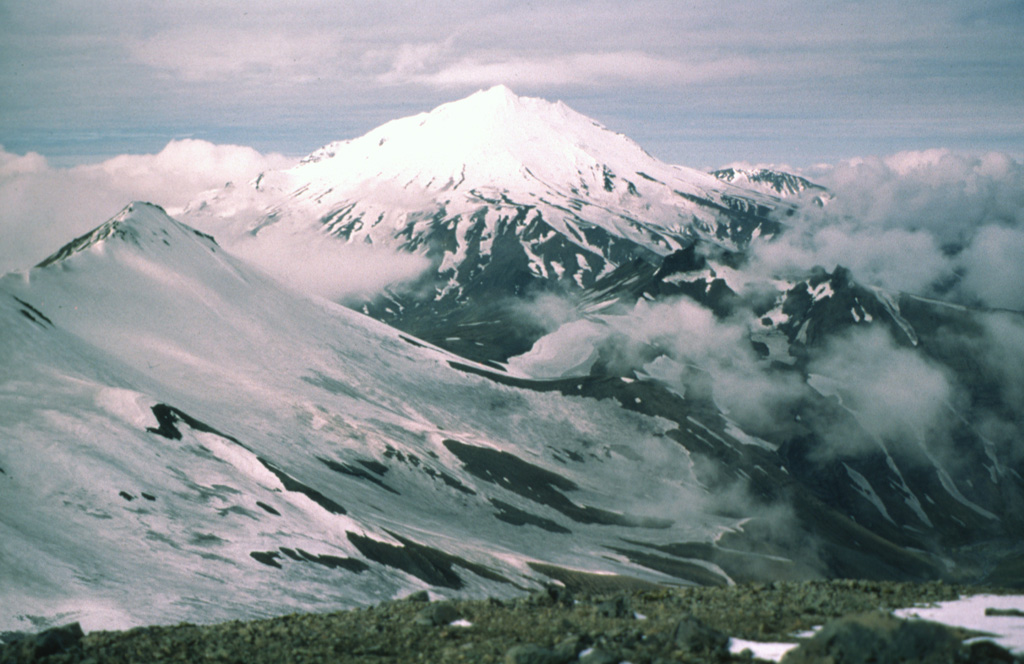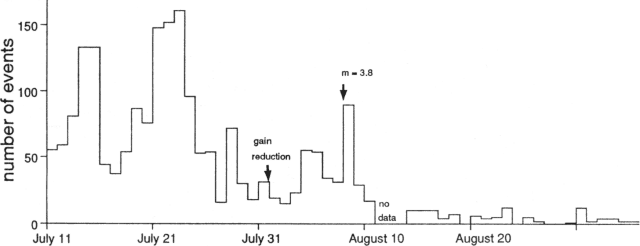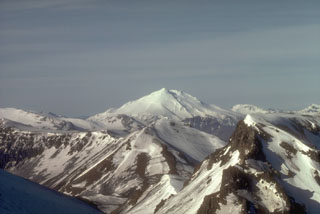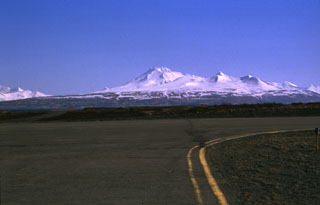

Seismicity drops but remains in background
"Seismicity near Mt. Dutton has continued at a low level since the last day of high activity on 8 August. Earthquakes have been high-frequency in character (i.e. not low-frequency volcanic events) and the best-located hypocenters lay at shallow depths (1-10 km) beneath the volcano's SE flank. Figure 1 shows three pulses of high activity followed by a few events/day through 4 September. This level of activity is still much higher than the background rate of a few events/year that existed before the swarm started in July."
 |
Figure 1. Number of events/day recorded at station DRRZ (28 km from the summit of Mt. Dutton). The data are not corrected for a reduction in gain on the helicorder on 1 August. |
Information Contacts: John Taber, Lamont-Doherty Geological Observatory, NY.
The Global Volcanism Program has no Weekly Reports available for Dutton.
Reports are organized chronologically and indexed below by Month/Year (Publication Volume:Number), and include a one-line summary. Click on the index link or scroll down to read the reports.
Earthquake swarm
On 10 July, a swarm of small shallow earthquakes began SW of Mt. Dutton. Epicenters gradually migrated NW underneath the mountain's SW flank. The events were similar to a smaller swarm that occurred in 1984. On 15 July and 8 August, days of peak activity, earthquakes (M<=3.8) were felt in the King Cove and Cold Bay areas, ~13 km S and 28 km W of Mt. Dutton, respectively. No harmonic tremor or B-type events have been recorded, and geologists have been unable to determine whether the seismicity is related to magma migration or tectonic movement. During reconnaissance field investigations on 25 and 26 July, T. Miller observed no evidence of gas emission, melting snow, or other changes to the edifice, and no historical volcanic activity has been documented. Holocene activity is indicated by unglaciated pyroclastic deposits on the E flank, debris avalanches on the S flank, and a dome on the NE flank. No surface faults have been mapped with trends similar to current seismicity. Lamont-Doherty's pre-existing regional seismic network and two supplemental seismic stations recently installed on the volcano's slopes by the AVO were recording daily earthquake activity as of mid-August.
Information Contacts: M.E. Yount and T. Miller, Branch of Alaskan Geology, USGS Anchorage; Klaus H. Jacob, Lamont-Doherty Geological Observatory, NY; J. Reeder, ADGGS; John Power, Univ of Alaska Geophysical Institute, Fairbanks.
Seismicity drops but remains in background
"Seismicity near Mt. Dutton has continued at a low level since the last day of high activity on 8 August. Earthquakes have been high-frequency in character (i.e. not low-frequency volcanic events) and the best-located hypocenters lay at shallow depths (1-10 km) beneath the volcano's SE flank. Figure 1 shows three pulses of high activity followed by a few events/day through 4 September. This level of activity is still much higher than the background rate of a few events/year that existed before the swarm started in July."
 |
Figure 1. Number of events/day recorded at station DRRZ (28 km from the summit of Mt. Dutton). The data are not corrected for a reduction in gain on the helicorder on 1 August. |
Information Contacts: John Taber, Lamont-Doherty Geological Observatory, NY.
The Global Volcanism Program has no synonyms or subfeatures listed for Dutton.
|
|
||||||||||||||||||||||||||
The Global Volcanism Program is not aware of any Holocene eruptions from Dutton. If this volcano has had large eruptions (VEI >= 4) prior to 10,000 years ago, information might be found on the Dutton page in the LaMEVE (Large Magnitude Explosive Volcanic Eruptions) database, a part of the Volcano Global Risk Identification and Analysis Project (VOGRIPA).
There is no Deformation History data available for Dutton.
There is no Emissions History data available for Dutton.
 Mount Dutton, seen here from the NE with the wall of Emmons Lake caldera in the foreground, is located near the tip of the Alaska Peninsula. Successive lava domes form the summit; collapse events during the Holocene produced debris avalanches that traveled to the west and also reached Belkofski Bay to the south.
Mount Dutton, seen here from the NE with the wall of Emmons Lake caldera in the foreground, is located near the tip of the Alaska Peninsula. Successive lava domes form the summit; collapse events during the Holocene produced debris avalanches that traveled to the west and also reached Belkofski Bay to the south. Mt. Dutton viewed from the airport runway at Cold Bay at the tip of the Alaska Peninsula.
Mt. Dutton viewed from the airport runway at Cold Bay at the tip of the Alaska Peninsula. Mount Dutton near the tip of the Alaska Peninsula is seen here from the NE. Successive lava domes overlying lava flows form the summit. Dome and flank collapse during the Holocene produced debris avalanche that traveled to the west and also reached Belkofski Bay to the south.
Mount Dutton near the tip of the Alaska Peninsula is seen here from the NE. Successive lava domes overlying lava flows form the summit. Dome and flank collapse during the Holocene produced debris avalanche that traveled to the west and also reached Belkofski Bay to the south. Maps are not currently available due to technical issues.
The maps shown below have been scanned from the GVP map archives and include the volcano on this page. Clicking on the small images will load the full 300 dpi map. Very small-scale maps (such as world maps) are not included.
There are no samples for Dutton in the Smithsonian's NMNH Department of Mineral Sciences Rock and Ore collection.
| Alaska Volcano Observatory (Link to Dutton) | The Alaska Volcano Observatory (AVO) is a joint program of the U.S. Geological Survey (USGS), the Geophysical Institute of the University of Alaska Fairbanks (UAFGI), and the State of Alaska Division of Geological and Geophysical Surveys (ADGGS). AVO was formed in 1988, and uses federal, state, and university resources to monitor and study Alaska's hazardous volcanoes, to predict and record eruptive activity, and to mitigate volcanic hazards to life and property. |
| Copernicus Browser | The Copernicus Browser replaced the Sentinel Hub Playground browser in 2023, to provide access to Earth observation archives from the Copernicus Data Space Ecosystem, the main distribution platform for data from the EU Copernicus missions. |
| MIROVA | Middle InfraRed Observation of Volcanic Activity (MIROVA) is a near real time volcanic hot-spot detection system based on the analysis of MODIS (Moderate Resolution Imaging Spectroradiometer) data. In particular, MIROVA uses the Middle InfraRed Radiation (MIR), measured over target volcanoes, in order to detect, locate and measure the heat radiation sourced from volcanic activity. |
| MODVOLC Thermal Alerts | Using infrared satellite Moderate Resolution Imaging Spectroradiometer (MODIS) data, scientists at the Hawai'i Institute of Geophysics and Planetology, University of Hawai'i, developed an automated system called MODVOLC to map thermal hot-spots in near real time. For each MODIS image, the algorithm automatically scans each 1 km pixel within it to check for high-temperature hot-spots. When one is found the date, time, location, and intensity are recorded. MODIS looks at every square km of the Earth every 48 hours, once during the day and once during the night, and the presence of two MODIS sensors in space allows at least four hot-spot observations every two days. Each day updated global maps are compiled to display the locations of all hot spots detected in the previous 24 hours. There is a drop-down list with volcano names which allow users to 'zoom-in' and examine the distribution of hot-spots at a variety of spatial scales. |
|
WOVOdat
Single Volcano View Temporal Evolution of Unrest Side by Side Volcanoes |
WOVOdat is a database of volcanic unrest; instrumentally and visually recorded changes in seismicity, ground deformation, gas emission, and other parameters from their normal baselines. It is sponsored by the World Organization of Volcano Observatories (WOVO) and presently hosted at the Earth Observatory of Singapore.
GVMID Data on Volcano Monitoring Infrastructure The Global Volcano Monitoring Infrastructure Database GVMID, is aimed at documenting and improving capabilities of volcano monitoring from the ground and space. GVMID should provide a snapshot and baseline view of the techniques and instrumentation that are in place at various volcanoes, which can be use by volcano observatories as reference to setup new monitoring system or improving networks at a specific volcano. These data will allow identification of what monitoring gaps exist, which can be then targeted by remote sensing infrastructure and future instrument deployments. |
| Volcanic Hazard Maps | The IAVCEI Commission on Volcanic Hazards and Risk has a Volcanic Hazard Maps database designed to serve as a resource for hazard mappers (or other interested parties) to explore how common issues in hazard map development have been addressed at different volcanoes, in different countries, for different hazards, and for different intended audiences. In addition to the comprehensive, searchable Volcanic Hazard Maps Database, this website contains information about diversity of volcanic hazard maps, illustrated using examples from the database. This site is for educational purposes related to volcanic hazard maps. Hazard maps found on this website should not be used for emergency purposes. For the most recent, official hazard map for a particular volcano, please seek out the proper institutional authorities on the matter. |
| IRIS seismic stations/networks | Incorporated Research Institutions for Seismology (IRIS) Data Services map showing the location of seismic stations from all available networks (permanent or temporary) within a radius of 0.18° (about 20 km at mid-latitudes) from the given location of Dutton. Users can customize a variety of filters and options in the left panel. Note that if there are no stations are known the map will default to show the entire world with a "No data matched request" error notice. |
| UNAVCO GPS/GNSS stations | Geodetic Data Services map from UNAVCO showing the location of GPS/GNSS stations from all available networks (permanent or temporary) within a radius of 20 km from the given location of Dutton. Users can customize the data search based on station or network names, location, and time window. Requires Adobe Flash Player. |
| DECADE Data | The DECADE portal, still in the developmental stage, serves as an example of the proposed interoperability between The Smithsonian Institution's Global Volcanism Program, the Mapping Gas Emissions (MaGa) Database, and the EarthChem Geochemical Portal. The Deep Earth Carbon Degassing (DECADE) initiative seeks to use new and established technologies to determine accurate global fluxes of volcanic CO2 to the atmosphere, but installing CO2 monitoring networks on 20 of the world's 150 most actively degassing volcanoes. The group uses related laboratory-based studies (direct gas sampling and analysis, melt inclusions) to provide new data for direct degassing of deep earth carbon to the atmosphere. |
| Large Eruptions of Dutton | Information about large Quaternary eruptions (VEI >= 4) is cataloged in the Large Magnitude Explosive Volcanic Eruptions (LaMEVE) database of the Volcano Global Risk Identification and Analysis Project (VOGRIPA). |
| EarthChem | EarthChem develops and maintains databases, software, and services that support the preservation, discovery, access and analysis of geochemical data, and facilitate their integration with the broad array of other available earth science parameters. EarthChem is operated by a joint team of disciplinary scientists, data scientists, data managers and information technology developers who are part of the NSF-funded data facility Integrated Earth Data Applications (IEDA). IEDA is a collaborative effort of EarthChem and the Marine Geoscience Data System (MGDS). |